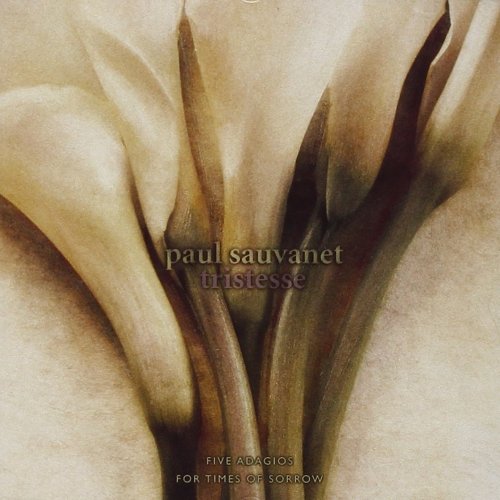
Paul Sauvanet - Tristesse: Five Adagios for Times of Sorrow (1995)
BAND/ARTIST: Paul Sauvanet
- Title: Tristesse: Five Adagios for Times of Sorrow
- Year Of Release: 1995
- Label: Valley
- Genre: Modern Classical
- Quality: APE (image+.cue,log)
- Total Time: 52:18
- Total Size: 238 Mb
- WebSite: Album Preview
Tracklist:
1. Adieu
2. Prayer for the Suffering
3. Canticum
4. Earth and Dust
5. Memories
1. Adieu
2. Prayer for the Suffering
3. Canticum
4. Earth and Dust
5. Memories
Tristesse in French means sadness - the quiet heartache of remembrance. Contemplation of such melancholy emotions is the focus of French composer PAUL SAUVANET's eloquently tender music for digital chamber orchestra. Contemplation of Tristesse - the quiet heartache of remembrance emotions is the focus of French composer PAUL SAUVANET's eloquently tender music for digital chamber orchestra. Recorded after the death of his mother, Sauvanet has transformed his personal experience into a meditation on mortality, mourning for lost relationships, and the bittersweet pain of letting go. Sauvanet's idealized chamber orchestra, a creation of the electronic studio -- is soft, redemptive, subtle, always moving. In much the same way Samuel Barber's Adagio for Strings underscored our collective passage through national tragedies since the 40's, Sauvanet's Tristesse: Five Adagios for Times of Sorrow may become a sound to soften the rocky transitions of the 90's.
Turning away from his early avant-garde work in electronic music, improvised jazz and rock, Sauvanet here returns to tonality and a more traditional sense of soothing pulse, using a chamber string orchestra as an unobtrusive cushion of tenderness on which to set his lyric ideas. He plays the melodic lines himself as synthesized suggestions of traditional orchestral instruments: harp, flute, oboe, and the arch Romantic timbre of a distant French horn. The effect, while original, is not unlike the mood injections in Henryk Gorecki's famous Third Symphony for soprano and orchestra - basically a soft, quiet string undulation held under flowing vocal lines. Just as the Gorecki work is subtitled Symphony of Sorrowful Songs, Sauvanet's Tristesse is subtitled Five Adagios for Times of Sorrow.
The individual titles of the Adagio cycle sketch their moods. The nearly Mozartian opening of "Adieu" gives way to Mahlerian pastoral hints, with the sounds of harp, horn and oboe singing out. "Prayer for the Suffering," which follows, leans more toward a Baroque religious aria, with something of the aroma of Purcell about it. That's followed by the gentle soaring "Canticum." Once the melodic duet of unobtrusive counterpoint begins, many of the resolutions rise, rather than have expected falling motions, which partly accounts for the music's sense of optimism.
"Earth and Dust," fourth of the Adagios, is the most sober movement in the cycle, further emphasizing the interlocking motives of all five sections. Naturally, individual experience comes to bear for the individual listeners, although the starry glint of the central section, set over a "walking bass" serves to remind the ear that we and the planet are all essentially made of the same star stuff. It's as if the traditional Biblical, "Dust thou art, and to dust thou shalt return," had been changed to, "Stars thou art ..."
Turning away from his early avant-garde work in electronic music, improvised jazz and rock, Sauvanet here returns to tonality and a more traditional sense of soothing pulse, using a chamber string orchestra as an unobtrusive cushion of tenderness on which to set his lyric ideas. He plays the melodic lines himself as synthesized suggestions of traditional orchestral instruments: harp, flute, oboe, and the arch Romantic timbre of a distant French horn. The effect, while original, is not unlike the mood injections in Henryk Gorecki's famous Third Symphony for soprano and orchestra - basically a soft, quiet string undulation held under flowing vocal lines. Just as the Gorecki work is subtitled Symphony of Sorrowful Songs, Sauvanet's Tristesse is subtitled Five Adagios for Times of Sorrow.
The individual titles of the Adagio cycle sketch their moods. The nearly Mozartian opening of "Adieu" gives way to Mahlerian pastoral hints, with the sounds of harp, horn and oboe singing out. "Prayer for the Suffering," which follows, leans more toward a Baroque religious aria, with something of the aroma of Purcell about it. That's followed by the gentle soaring "Canticum." Once the melodic duet of unobtrusive counterpoint begins, many of the resolutions rise, rather than have expected falling motions, which partly accounts for the music's sense of optimism.
"Earth and Dust," fourth of the Adagios, is the most sober movement in the cycle, further emphasizing the interlocking motives of all five sections. Naturally, individual experience comes to bear for the individual listeners, although the starry glint of the central section, set over a "walking bass" serves to remind the ear that we and the planet are all essentially made of the same star stuff. It's as if the traditional Biblical, "Dust thou art, and to dust thou shalt return," had been changed to, "Stars thou art ..."
DOWNLOAD FROM ISRA.CLOUD
Paul Sauvanet Tristesse 5 Adagios for Times of Sorrow 95 2906.rar - 237.8 MB
Paul Sauvanet Tristesse 5 Adagios for Times of Sorrow 95 2906.rar - 237.8 MB
As a ISRA.CLOUD's PREMIUM member you will have the following benefits:
- Unlimited high speed downloads
- Download directly without waiting time
- Unlimited parallel downloads
- Support for download accelerators
- No advertising
- Resume broken downloads


